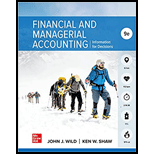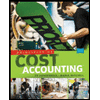
(a)
Introduction: When a physical inventory count is done, a periodic inventory system just updates the ending inventory balance in the general ledger. Few businesses perform physical inventory counts more frequently than once every quarter or year because they are time-consuming.
To find: Ending inventory and cost of goods sold using FIFO method.
(b)
Introduction: When a physical inventory count is done, a periodic inventory system just updates the ending inventory balance in the general ledger. Few businesses perform physical inventory counts more frequently than once every quarter or year because they are time-consuming.
To find: Ending inventory and cost of goods sold using LIFO method.
(c)
Introduction: When a physical inventory count is done, a periodic inventory system just updates the ending inventory balance in the general ledger. Few businesses perform physical inventory counts more frequently than once every quarter or year because they are time-consuming.
To find: The value of gross profit.
Want to see the full answer?
Check out a sample textbook solution
Chapter 5 Solutions
FINANCIAL+MGRL.ACCT.(LL)-W/CODE>CUSTOM<
- accountingarrow_forwardHello tutor please help me accounting questionarrow_forwardOn October 1, 2023, Galaxy Tours Ltd. borrowed $240,000 by signing a 1-year note with an 8% annual interest rate. The interest is payable at maturity on September 30, 2024. What amount of interest payable should Galaxy Tours report on December 31, 2023? a) $12,800 b) $9,600 c) $6,400 d) $4,800arrow_forward
- Cottonwood Company reports the following operating results for the month of August: sales $347,900 (units 4,970); variable costs $216,000; and fixed costs $97,200. Management is considering the following independent courses of action to increase net income. 1. Increase selling price by 11% with no change in total variable costs or units sold. 2. Reduce variable costs to 51% of sales. Compute the net income to be earned under each alternative.arrow_forwardMetro Inc. sells a product with the following data: • Selling price per unit: $50 • • Contribution margin ratio: 20% Fixed costs: $180,000 Using the contribution margin ratio approach, determine the sales in dollars and in units needed to achieve a target profit of $60,000.arrow_forwardGeneral accountingarrow_forward
- Principles of Accounting Volume 1AccountingISBN:9781947172685Author:OpenStaxPublisher:OpenStax College
 Financial And Managerial AccountingAccountingISBN:9781337902663Author:WARREN, Carl S.Publisher:Cengage Learning,
Financial And Managerial AccountingAccountingISBN:9781337902663Author:WARREN, Carl S.Publisher:Cengage Learning, Principles of Cost AccountingAccountingISBN:9781305087408Author:Edward J. Vanderbeck, Maria R. MitchellPublisher:Cengage Learning
Principles of Cost AccountingAccountingISBN:9781305087408Author:Edward J. Vanderbeck, Maria R. MitchellPublisher:Cengage Learning - Century 21 Accounting Multicolumn JournalAccountingISBN:9781337679503Author:GilbertsonPublisher:Cengage
 Cornerstones of Financial AccountingAccountingISBN:9781337690881Author:Jay Rich, Jeff JonesPublisher:Cengage Learning
Cornerstones of Financial AccountingAccountingISBN:9781337690881Author:Jay Rich, Jeff JonesPublisher:Cengage Learning





